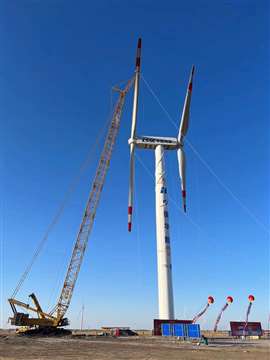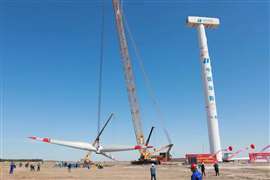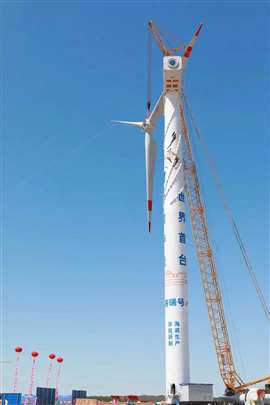Dual rotor wind turbine installation
27 July 2023
 The XCMG XGC11000A mounting the second rotor. Photo: XCMG
The XCMG XGC11000A mounting the second rotor. Photo: XCMG
More power in a smaller package for less money is the promise for an unusual type of wind turbine with two rotors arranged in tandem. Easier component transport, handling and assembly are benefits on the lifting and transport side.
The Huaneng Sairui is a 2.7 MW turbine with two rotors, arranged in tandem. It was erected at the Huaneng Jilin Tongyu wind farm in Jilin, China, as part of a national research and development project.
The crane used to erect it was a 1,000 tonne capacity XGC11000A lattice boom crawler crane from Chinese manufacturer XCMG. It was set up in the “standard” wind power installation configuration of 96 metre main boom plus 12 metre jib.
 Picking the first of two 55 tonne rotors. Photo: XCMG
Picking the first of two 55 tonne rotors. Photo: XCMG
What are the heaviest components?
The turbine’s heaviest component was the nacelle at 170 tonnes, followed by the first base tower section at 111 tonnes and then the complete rotor at 50 tonnes.
For the almost the same power output the dual rotor turbine’s blades are nearly half the length of an equivalent single rotor turbine. This makes transport to site much easier. In addition, generating efficiency is reported to be 15 per cent higher and the cost 10 % lower. A further benefit is that less space is required on wind farm sites.
In total, the above means both the number of units and the generating capacity can be increased by more than 50 %, according to China Huaneng Group Co., Ltd.
 Lifting the first of the two rotors for the 2.7 MW turbine. Photo: XCMG
Lifting the first of the two rotors for the 2.7 MW turbine. Photo: XCMG
STAY CONNECTED


Receive the information you need when you need it through our world-leading magazines, newsletters and daily briefings.




